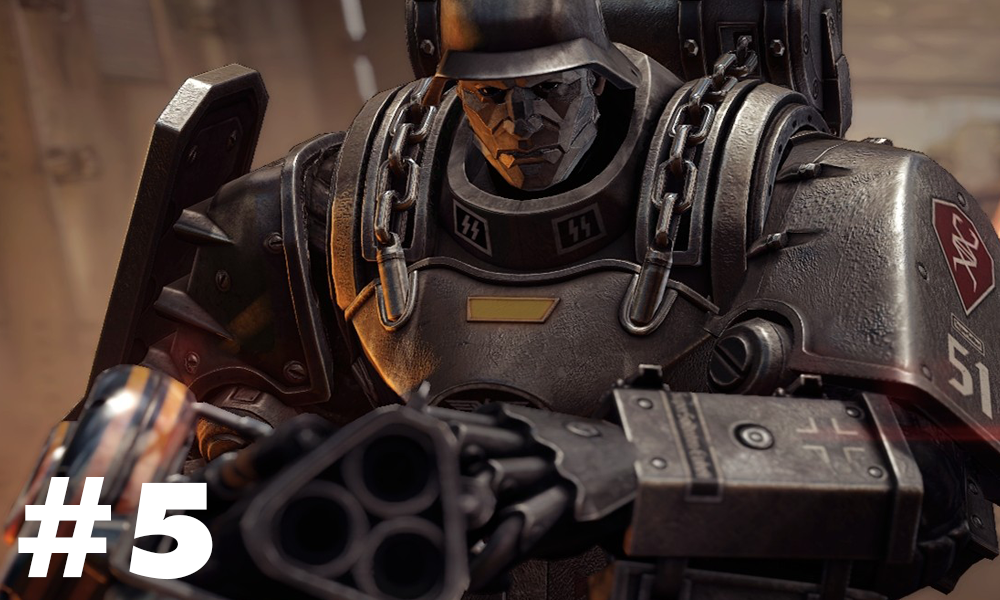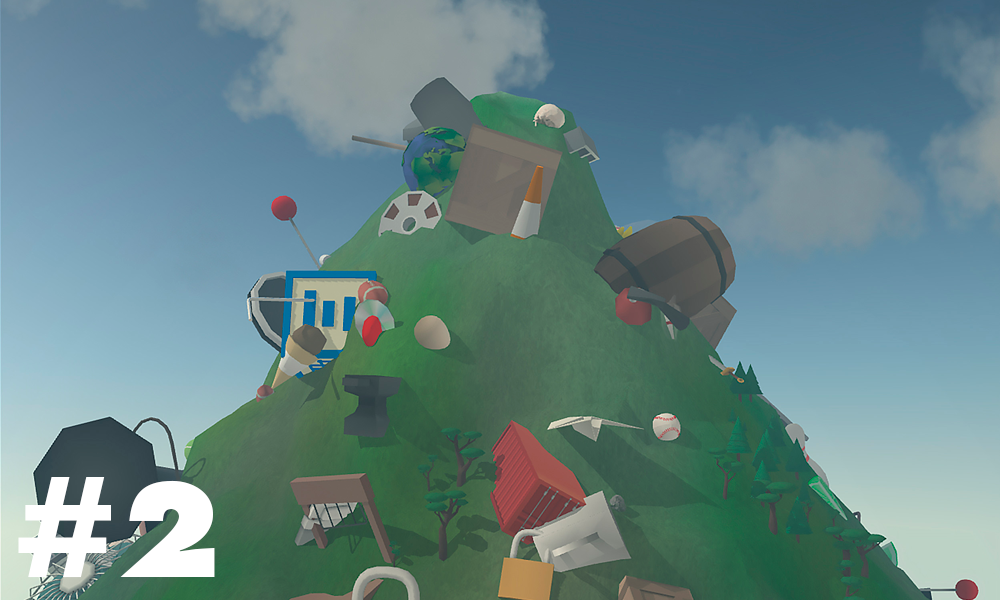Header image via Ollie Hoff
(Click here to read part one of our Best of 2014 list.)
(Click here to read part two of our Best of 2014 list.)
(You’re currently at part three of our Best of 2014 list.)
(Click here to see the rest of our year-end coverage.)
///
5. Wolfenstein: The New Order

There was not a better first-person shooter this year than Wolfenstein. It just isn’t possible. B.J. Blazkowicz stands tall, a bicep-straining cobalt shotgun in one hand and a bloodstained knife in the other. Every aspect of the game evinces an obsessive, almost Kubrickian attention to detail, starting with Blazkowicz’s constant narration. He complains, muses, reminisces, quips gruffly and often about a life spent killing Nazis, or the Grill Dad future never to be. The writing has the terse uber-machismo of James Ellroy at a boxing match, earnest pathos delivered bluntly.
So bluntly, in fact, that you might blanch. Is it clumsy or is it just stupid? But it works on you slowly. Blazkowicz wins you over in the end, with his Oliver Reed chest and big wet puppy eyes. Every character wins you over, eventually, so carefully rendered are they, even the villains. A sadistic duo of SS officers have a romance as vividly sketched as the one between resistance fighter Anya and Blazkowicz. Yes, there are alien relics and moon bases and giant mech suits: a boatload of daft along with the deft. But even the words “Spindly Torque” cannot sink Wolfenstein. Adult people would be satisfied with writing this, with no lingering shame when they caught a glimpse of themselves in a mirror.
All this is to say that Wolfenstein is closer to Tarantino than to Call of Duty. It doesn’t have Tarantino’s smartass mouth, but it does have his abiding taste for cultural detritus taken straight. This thing is exploitation from top to bottom, from the Verhoeven gore to the pulp premise, but it plays it so close to the vest. It lets you revel in the crunch of its shooting, the headlong dash of its plot, the vivid sprawl of its environments, presenting a beautiful vision of a horrible world so that you, too, might find something to love. Would that all games had such heart.
— Zach Budgor
4. Monument Valley

The title speaks to its playful regard for paradox. A valley is a low point, a stretch of earth carved out by time and erosion, an absence given a name through what it is not: what remains. A monument is all that remains of something, or someone, else: A remembrance of heroism or horror whose ultimate goal is for us to never forget.
Ustwo games knows that any paradox—an impossible archway, or a river flowing up, or a fortress floating in the sky—needs both sides to exist. A puzzle is nothing without a solution. Joy exists only in the face of sadness. A life is worthless without that life, one day, coming to an end.
Monument Valley is a simple, beautiful, compelling, accessible game. It’s an argument that games can be all things to all people. Simple mechanics (tap to move) need not be tamped down by accompanying blandness. Beauty (snap a screenshot) not always masks something shallow or frail beneath. I played the entirety of the game in two sittings, not because I wanted to be finished, but because I didn’t want to stop. When I saw my father’s girlfriend playing it over Thanksgiving, and then my eight-year-old niece playing, too, I knew why.
You start in a garden “on a quest for forgiveness.” You end in an observatory, your perfect, impossible puzzle box touching water below and the stars above. Your only enemies do not kill you but merely impede your progress. That your character, Ida, is clad all in white and these oppositional foils are black crows whose beaks resemble the shape of your hat is no accident. We are defined by our others. Whether you color inside or outside the lines, the resultant shape will be the same.
Monument Valley is inclusive in a world insisting on exclusion. My experience playing may be different than that of my niece, or you, but ultimately our experience is the same: We will remember.
— Jon Irwin
3. P.T.

Boy meets girl. Boy marries girl, becomes a man. Husband with white-picket fence and 2.5 children murders every last one of them in their sleep—wife’s side of the bed still warm as blood streams from her bulging belly.
You’d think stories like these would be anomalies in the grand scheme of things. But they aren’t. In fact, shattered domesticity seems to be one of horror’s most archetypal forms, revealing the fragility of our cozy veneers as we secretly hunger for something more.
The man-murders-family-because-of-the-demon-inside-him trope has been reused so many times that it’d be foolish not to question why we can’t get enough of it. In most other instances (Amityville Horror, American Horror Story, The Shining, etc.), directors feel some obligation to imbue the tale with a forced sense of empathy. Presumably, we should feel sorry for these people, right? Cluck our tongues at their tragedy while lamenting, “What a shame—they seemed so normal.”
But P.T. concerns itself with none of that. Our first and only source of narrative, the radio, recounts the story with almost delightful bravado. At first, the newscaster’s tone is unsettlingly removed from the horror, rattling off the facts of a family massacre with the same intonation as a story about a bulldog who learned to skateboard.
As we spiral again and again around the same bend in the same hallway, the hints of madness transform into unabashed pleasure. “Don’t touch that dial now!” he singsongs. “Gouge her eye out,” he urges, gravely voice commanding you to take part in the tragedy like no other domestic horror has ever dared to.
With no pretense of empathy, delivering the story through a character that relishes in its savagery, P.T. raises the mirror to reveal our own faces in the cracked reflection. No one goes to these stories of domestic horror to feel bad for the family. We’re there to see our deepest fears and desires manifested. By making you complicit in the crime, that poor woman’s gouged eye following you sightlessly across the hallway, P.T. reminds you of the demon buried in us all.
Forcing the player into cohesion with the murderous madman doesn’t render P.T. a more dispassionate story. Rather, it garners a genuine sympathy for the victims, which can so often feel forced in tales of domestic horror. Aside from Lisa’s terrifying omnipresence, she also manages to instill an unusual sense of self-aware guilt in the player. Allowing us to take unadulterated pleasure in her painful demise only serves to garner compassion for the game’s main boogeyman—a compassion unmatched by even the most tragic and blameless Japanese little girl monster.
Lisa’s crying haunts you not because it’s ghostly, but because it seems to ask why—how could you do this to me? We never get an answer, but carry the shame of it like a lead weight with each step taken in the unending labyrinth of a broken family.
— Jess Joho
2. Mountain

In 1927, Professor Thomas Parnell attempted to demonstrate to his University of Queensland students a bit of the magic of physics. Some seeming solids are, in fact, liquids, and to illustrate this Parnell poured a bit of bitumen into a funnel, let it settle for three years, cut the bottom, and then waited. Over the last 80+ years, this black bit of pitch, known as “the pitch drop experiment,” has formed a droplet and released it 8 times. But in a bit of tree/forest irony, no one had observed it.
Perhaps no one felt this pain more than its custodian John Mainstone, an honorary mathematics professor who tended to the Guinness-winning longest running experiment for more than 50 years. Mainstone missed observing the drops fall a tantalizing three times: by a day in 1977, by just five minutes in 1988 and, perhaps again, in 2000, when the webcam that was recording it was hit by a mysterious 20-minute power outage. In August 2013, Mainstone died of a stroke, never having watched the drop fall. Nine months later, the pitch fell again with the webcam running, thus ending an eight-decade odyssey. “It’s a pity of course that the person in charge died about a year ago, so he never saw the drop,” a colleague said. “He would have enjoyed that.”
Mainstone watched and waited for something outside of his control. Ironically, in a medium for which one hallmark is control, that experience—of watching and waiting everyday until something, someday happens—sits exactly at the center of David O’Reilly’s Mountain.
Mountain both mocks and praises the tradition that birthed it. It is a “god-game” in the tradition of Civilization or Populous, a game that places you at the the helm of a miniature world. Your mountain is culled from a psychological chamber of questions and created from your sub-conscious. Mountain then generates a mountain for your from those answers. This is all sleight-of-hand, of course, but the suggestion is that the Mountain is an extension of yourself.
Your Mountain will live and spin and sing. It will wonder and pontificate. It will collect objects—giant cakes and bowling balls and anvils—and snow will fall on its contours; your mountain reflects each brand new day. But you can only watch as a loving parent does as your mountain grows and evolves just beyond your reach. You are not the active and personal god found in the monotheistic religions, but are more like a deist conception lauded by thinkers like Benjamin Franklin. You may have set this world on its tilt, but it spins on without you. The instructions to Mountain reaffirm this. The controls are merely listed “nothing.”
As a self-described “mountain simulator,” O’Reilly explicitly pokes fun at the glut of simulators that had flooded the market since the success of Goat Simulator. In that sense it is positively part of the larger chorus of game-making in that O’Reilly is happily placing Mountain in contraposition to both the flippant anti-games of 2014 but also the larger movements from bigger game makers that seek to give players more and more granular control over their digital existences. If you are not not happy, then you need merely adjust the dials. But you are not in control. Games are not your release. What you put in is defiantly not what you get out.
One could read all of this trained helplessness as a cynical slap to those that love games, a $1.99 trick to fool those trusting enough to believe in something unique. In era of “quantified self,” designer data tracking, and leveraging self-monitoring for personal transcendence, Mountain explicitly states that there are simply unknown unknowns. And yes, O’Reilly is lampooning the state of games as an outsider, but only to suggest something larger. That a first-time game designer would arrive at such a needed and provocative conclusion only speaks to how competitive the landscape for game design will become in the near future. O’Reilly is a director by trade, and designed some of the experiences of Spike Jonze’s Her, another work that mocks the idea of human control over machines.
But of course, there is a moment when your mountain needs your divine intervention. It follows no timetable, and yet, it will ingloriously end your run. It has many names: Fluffy the Destroyer and the Icosahedron of Doom. In that moment, perhaps while you are sleeping or in the bathroom or merely not paying attention, your mountain will cry out in need of a savior. You may be there to catch it when it falls. But maybe not.
— Jamin Warren
1. Kentucky Route Zero, Act 3

There was nothing else this year like Junebug. We meet her roaring down a highway on a motorcycle, her boyfriend Johnny riding in the sidecar. Something dirty and lo-fi bangs from the speakers, equal parts Dirty Beaches and Chromatics, while Johnny talks about the stars. He’s the romantic yin to her badass yang. “Keep on dreaming, and I’ll keep on driving,” she tells him, her triangle of blue hair waving behind her like a pennant.
Later, in a dingy bar called The Lower Depths, she sings, and she blows the roof off the place. Literally: first comes the long, melancholy beat, then the blue lights, then the ceiling dissembling in slats, rising heavenward, so that we see a star peel across the night sky. Have you felt this before? That swaying moment in a cigarette-strewn pisshole. I’d forgotten how often I once did. You’re waiting for your next drink and then all of a sudden—music! Here come the cosmos, the stars; here comes Junebug, in a pale blue a-line dress, howling dead love over rolling synthesizers.
Conway, the protagonist of this narrative, has been waiting for his next drink, too. He begins this episode dreaming, again, of horses—of things the way they once were, over a cup of coffee with his wife. But by the end he’s off the wagon and back in a hole. He’s falling apart—skin and bones, just like his dog—and it has become increasingly clear that this five-part journey he’s on will end either in or near his grave. His vehicle is breaking right alongside his body. He talks shop with a glowing skeleton about a delivery truck but keeps blanking out, the truck dredging up memories of his wife and his time with the bottle. The road may be an old metaphor for life, but it’s a good one, and Kentucky Route Zero explores it with the quiet, determined purpose of a Faulkner short story—who, not coincidentally, also saw the American south as a simulacra of a person’s soul.
And so the tiny alternate paths we’re given to choose from here are just like those we take in our lives—coffee black or with a little sugar, ask about the insurance costs or let it slide silently. They add up, eventually, to whatever it is we become: the trucks in which we rattle on down the Zero. Junebug, for her part, chooses radicalness; it’s not even a question, by the time we meet her, but in an astonishing monologue she reveals that it once was. “You think I was born this foxy?” she jabs at Ezra, the curious, tag-along kid, before continuing,
“I came off the assembly line about a half-foot shorter, and all gray. No eyes. They were going to have us clearing out the old mine. Doesn’t matter what you look like under all that rock and water: a bunch of gray shadows shoveling and hammering invisibly at the walls, draining the tunnels. Johnny found some gear—an old tape player. We hid away in an underwater cave and listened to it over and over, and we knew we weren’t miners … We slipped out onto the road, just these two featureless shadows, and ever since that night we’ve been detailing. Coloring in. Specifying. I feel more like myself every day.”
I relate to Ezra—he’s a quiet kid, but you can tell someday he won’t be—as much as I relate to Conway, blankly studying his life’s choices. I don’t know if I’m necessarily either, but I do know that Kentucky Route Zero is Junebug. Kentucky Route Zero chooses, defiantly, radicalness and beauty. Its dreamy architecture, Tarkovskyan long takes, and blissed-out sine waves are held together by their interactivity—as they were in last year’s acts—but there’s a new, strange glow about them here. The pupal ideas of the first act are grand, ripping themes here; the playful use of silhouette beneath the gas station is now the crackling Hall of the Mountain King. Of course, the game is still being written, but so, for today, are we all. The promise of episodic videogames, it turns out, is not merely the thrill of collective anticipation, but that of watching artists hit their stride in realtime, coloring in their lines, specifying—and then blowing the goddamn roof off.
— Clayton Purdom

Full list:
25. Valiant Hearts
24. Hohokum
23. The Wolf Among Us
22. 80 Days
21. Banner Saga
20. Dark Souls 2
19. Shovel Knight
18. Super Smash Bros
17. Samurai Gunn
16. Oneiric Gardens
15. This War of Mine
14. Shadowrun
13. Alien: Isolation
12. Sportsfriends
11. Threes!
10. Bayonetta 2
9. Desert Golfing
8. Nidhogg
7. Mario Kart 8
6. NaissanceE
5. Wolfenstein
4. Monument Valley
3. PT
2. Mountain
1. Kentucky Route Zero
(Click here to read part one of our Best of 2014 list.)
(Click here to read part two of our Best of 2014 list.)
(You’re currently at part three of our Best of 2014 list.)
(Click here to see the rest of our year-end coverage.)
